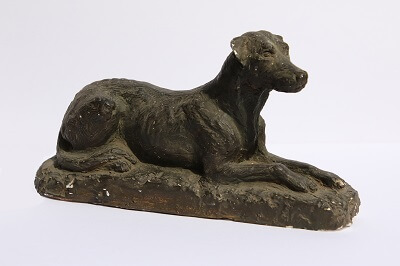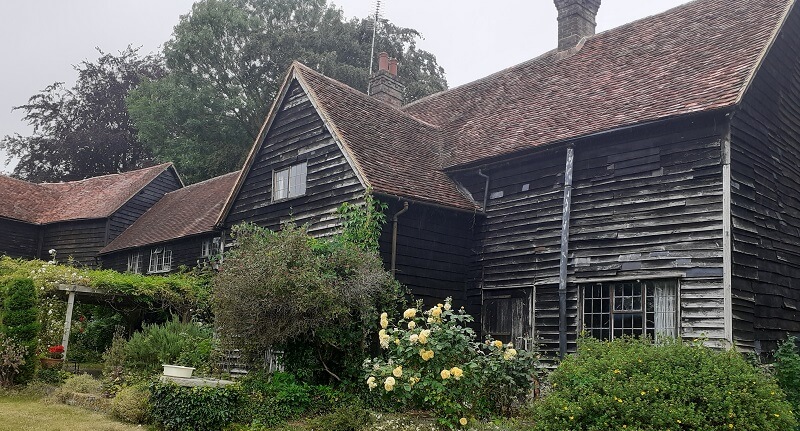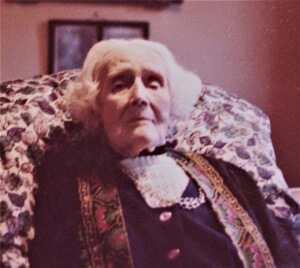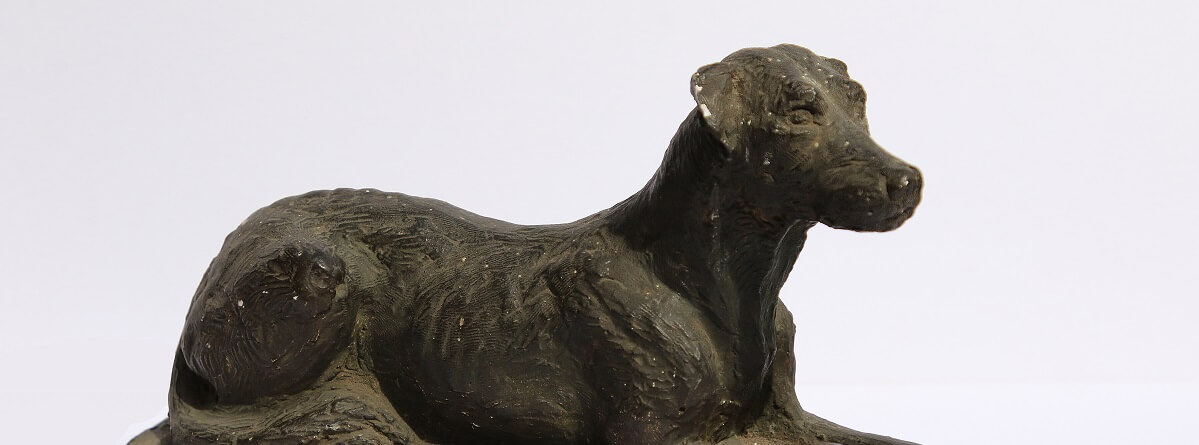By Alison Bailey, July 2023
Augusta North was a local artist who regularly exhibited in Amersham during the 1930s and had a picture in the Royal Academy in 1930. In 1921 she moved to a farm at Wendover Dean on the outskirts of the Amersham district and lived here until her death at the age of 100. During WWII she invited the Czech refugee, and distinguished sculptor, Mary Duras, to live with her when she could not find anywhere affordable to lodge in Amersham.
The dog sculpture

Miss North’s family have recently donated a sculpture of a dog to Amersham Museum which was made by Mary Duras and Augusta. Signed AN 42 it is believed to made by Augusta with Mary’s help and is very much in Mary’s style.
In 1944, at the barn, Mary created a self-portrait, a plaster bust titled Self-portrait with Cat. According to Ivo Habán, Mary Duras’s biographer: “Within the context of Marie Duras’ work, the representation of a human being together with an animal is rare, moreover, most of her figures are also represented without any attributes. From her estate, it is clear she had a positive relationship with animals. We know from period photographs that she owned a Doberman called Hassan in the 1930s, and later she liked cats. Despite her fondness of animals, representations of cats in her work are rare. In the context of Duras’ British self-portraits, the cat’s rigid, stern posture can be understood as a symbol of the Egyptian goddess Bastet and refers to her interest in Ancient Egyptian art that occasionally shows in her work”.
The identity of the dog is unknown, but the family suspects it was a farm dog. Augusta was particularly fond of cats. Her last cat was an overweight black cat called Glamour that could barely fit through the cat flap!
Norfolk
Augusta Louisa North, known as Dus or Dussie to the family (and later as Miss North to everyone else) was born the youngest of 13 children born to Captain Charles North and Augusta Keppel, on 15 January 1878. Her home, Rougham Hall, near Swaffham in rural Norfolk, has been the ancestral home of the North family, the descendants of the politician Dudley North, 4th Baron North (1602 –1677), for many generations. Augusta was one of a long line of formidable women. The Honourable Dudleya North (1675–1712) was a classical scholar, orientalist and linguist who was proficient in Latin, Ancient Greek, Hebrew, and several Eastern languages. Augusta’s aunt, Marianne North, (1830-1890) was the prolific Victorian botanical artist who travelled the word discovering plants and recording them in colourful detail before donating her entire collection of paintings to the Royal Botanic Gardens, Kew where they are on display today in the Marianne North Gallery of Botanic Art. This is still believed to be the only permanent solo exhibition by a female artist in Britain. Her scientific discoveries are also recorded in the many plant species named in her honour.
As was typical at the time, the family’s money was used to educate the boys at boarding school and Augusta was mainly educated at home with governesses whom she enjoyed tormenting. Her last governess resigned in tears when she was 14. When her mother was moaning about the money she would have to find for a replacement, Augusta said that she would much rather have a new pony and her wish was granted. Like her mother, she was a keen horsewoman and an enthusiastic supporter of the West Norfolk Hunt. One of her largest paintings was of mounted members of the hunt.
Augusta never married and after the death of her father in 1906, cared for her mother at home in Norfolk until her mother’s death in 1917. Augusta immediately volunteered as a VAD and served as an ambulance driver in France and Macedonia for the rest of WWI.
Buckinghamshire
In 1921 Augusta used her inheritance to invest in a farm near Wendover Dean with a group of friends she knew from the war. These included two former VADs, and a Major who was responsible for the farm’s finances. Augusta’s older brother, Majoribanks, his wife, Edith, and son, Mount, were living at Little Germains in Chesham which is probably how she first came to visit the area. Edith was the District Commissioner of the Girl Guides and involved Augusta in Girl Guiding events and fundraising. In 1927, she was a lieutenant in the 1st Chesham Girl Guides.

Augusta invited the Osbourne family from Norfolk to join them to farm the land and live in one of the farm cottages. It was very tough to make money from farming during the 1920s and the group broke up. Eventually Augusta managed to buy the others out, but to make ends meet, she had to sell some land and move out of the farmhouse into the neighbouring barn where she had her studio. She converted this into an Arts & Craft style house with a fine staircase and gallery. This became her home and studio for the rest of her long life. The farmhouse was then rented out to tenants before her nephew, Charles, returned from working as a civil servant in Africa and rented the farmhouse.
The Osbournes, and then their daughter Elsie Johncock and her husband, Douglas, stayed on to farm the land. Mary Johncock, Elsie’s daughter later modelled for Mary Duras who produced a bust of Mary with pigtails when she about nine years old.
In Buckinghamshire, Augusta socialised with the local gentry attending society events such as the 1925 wedding of Cicelie Lowndes at the Bury, Chesham and the 1937 wedding of the Hon John Charles Cavendish, the son of Lord Chesham of Latimer House. She was also a member of the Wendover and District Conservative Association. A keen bridge player, she often played at the Red Lion, Wendover. Whenever she travelled, she insisted that any letter addressed to ‘Miss A North, Wendover, England’ would find her – and it usually did. However, she formed friendships across all classes and was interested in everybody.
An Artist

Little is known of Augusta’s artistic training although she was widely exhibited in Buckinghamshire after moving to the area and joining local art societies such as the Chiltern Club of Arts and the Bucks Art Society. Her circle included the artists Louise Jopling, John Simmons and Fred Stubbings. Whilst attending classes at Regent Street Polytechnic she met talented etcher, Rachel Carnegie the daughter of the Sub-Dean of Westminster Abbey. Rachel had trained at the Slade and became a lifelong friend and more or less, an adopted daughter. 23 years younger than Augusta, Rachel had lost her own mother when she a baby. Augusta was always trying to marry her off to one of her nephews, before Rachel married one of her nephew’s friends.
The two women often travelled together on painting trips, particularly to Paris where Augusta had many artist friends. In 1928 Augusta drove them to Algeria where they stayed for several weeks. On the return trip the car ran out of petrol on the hill above Wendover. Putting the car into gear, Augusta coasted down the hill to the nearest garage. The owner asked where they had come from and was dumbfounded at her reply of “North Africa”!
In 1929, when she was 51, Augusta painted a striking, large self-portrait still owned by the family. She is standing, turning towards the viewer, facing confidently out, holding her pallet and brushes and wearing a painter’s smock over a dark dress. Her hair is touched with grey and styled neatly in short waves with some of her paintings framed on the wall behind her. The painting was described as “quite admirable in its sense of character and its bold handling” by a critic in the Buckinghamshire Advertiser in 1933.

Perhaps inspired by her aunt, Marianne North’s travels, Augusta travelled every winter to paint in warmer climates. She used her extensive family connections to stay at distant relatives’ houses in Ceylon, India, Africa, and the Caribbean. She painted vibrant landscapes, and atmospheric portraits of the people she met whilst travelling. When many of these were exhibited in 1933, a critic admired “the artist’s versatility – she handles landscape, portrait and animal studies with equal skill”.
Augusta exhibited paintings regularly in Bucks Arts Society exhibitions in Amersham. In 1933 the Bucks Art Society gave her a solo exhibition the Griffin with 77 of her paintings which got extensive coverage in the local press. The exhibition also included local scenes such as Harvest, The Polo Ground Halton, and Above Small Dean. Jamaica Maid was picked out as being of particular merit, “a most capable oil portrait with good fine brushwork and broad treatment and most interesting palette”. This was the painting that had been exhibited at the Royal Academy in 1930.
Augusta was also a gifted copier of Old Masters, and was frequently commissioned to reproduce valuable family paintings if the owners needed to sell the originals. She prided herself on the casual viewer not being able to spot the difference. When picture owners were downsizing, she was also asked to reproduce their favourite paintings in smaller sizes!
Mary Duras
It is not known how Augusta and Mary originally met, although it may have been whilst Mary was lodging at Russellvue Farm in Wendover Dean in 1940. By the autumn of 1941 she was lodging with Augusta at the barn. When war broke out Mary was living in London as a refugee from Nazi occupied Czechoslovakia. Her Jewish husband, Arnold Schück, an entrepreneur and factory director, was still in Prague.
According to Ivo Habán: “Miss North, as the woman was known, was an artist and twenty years older than Mary Duras. Miss North converted an old 17th century barn into a comfortable studio for herself and had a former stable converted for Mary Duras as her own workshop. Duras found the most essential sculptor’s modelling tools and materials second-hand in London. Her first work was Churchill, a head portrait, that brought her success. Mary received commissions for children’s portraits through Miss North and the Czechoslovakian government-in-exile based in London also gave her financial support”. Mary also started selling her work to private art collectors. Busts made at the barn included Winston Churchill, Jan Masaryk the Foreign Minister of the Czechoslovak Government-in-Exile and her friend, the émigré artist, Marie-Louise von Motesiczky, who followed Mary to Amersham.
Mary had tried without success to get Arnold out and wished she had met Augusta before: “Right before the war started Arnold sent many valuable items to London, all the paintings and many books. It is surprising that the Germans let them through, but unfortunately not Arnold himself…If I had the acquaintances I gained through Miss North before I came to England, I would have not only got Arnold here, but also all his relatives. But I did not know anyone in England in May 1939. I lived with Miss North throughout the whole war and these years were bearable, given, if one can admit to that, the ongoing war and the fact that I was completely cut off from Arnold.”
Mary’s close friendship with the younger Expressionist artist, Marie-Louise von Motesiczky brought her often into Amersham where she joined her émigré circle. She also became a close friend of the writer, Elias Canetti and stayed in touch with him until the 1970s. Mary took part in several exhibitions during the war mostly for C.E.M.A. (Council for the Encouragement of Music and the Arts). She exhibited with Marie-Louise at the Exhibition of Allied Artists in RBA Gallery at Suffolk Street in 1942 and in a joint exhibition in the Czechoslovak Institute in London in the autumn of 1944.
During the war Augusta hosted regular events at the barn to which she invited her “Dear Boys” from RAF Halton for entertainment and relaxation.
After the War
At the beginning of May 1945, Mary declined a prestigious post as Art Director of the School of Sculpture at Edinburgh College of Art and decided to return to Prague after she learnt that her husband had survived Auschwitz. They were reunited after 6 years apart. She left several sculptures and tools in her barn studio, presumably planning to return. She visited Augusta just the once to introduce her to her husband. However, the two remained lifelong friends.
Augusta continued to exhibit her paintings with the Bucks Arts Society and the newly formed Aylesbury and District Art Society. In 1975, when she was 97, Augusta was interviewed by Cliff Michelmore on BBC 1’s Globetrotter as “probably the oldest globetrotter in the world”.

A succession of lodgers moved into the barn after Mary left, including an entertaining Bulgarian called Boris. As she got older, a lady’s companion was employed, but Augusta loved to bait them, as she had earlier tormented her governesses. Augusta North died in 1978 at the grand age of 100. Her asked for her ashes to be buried with favourite brother, Tom, who had died from the Spanish Flu 57 years earlier.
In 1981, a second joint exhibition was held at Rougham Hall, Two Rougham Lady Artists featuring paintings by Augusta and her aunt Marianne North to raise funds for the Red Cross. The exhibition also included some of the 38 scrapbooks of sketches and photographs that Augusta had created as a diary of her extraordinary life which are still treasured by her family.
Sources
Mary Clow
Jane Watherston
Mary Duras by Ivo Habán, translated by Lucie Malkova
British Newspaper Archive
Ancestry

